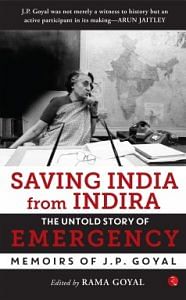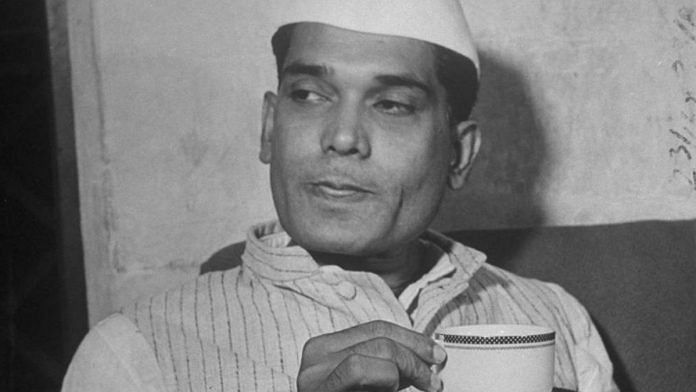It was confirmed that the information I had received from Shri Raj Narain that Shri Jayaprakash Narayan was detained at the PGI at Chandigarh was correct. I immediately telephoned Shri Rajeshwar Prasad at the Gandhi Peace Foundation and told him that Shri Jayaprakash Narayan was detained in the PGI at Chandigarh and that he should accompany me the next morning to Chandigarh. I also telephoned Shri V.M. Tarkunde and asked him to accompany me.
Nobody in Chandigarh knew that Shri Jayaprakash Narayan was detained there. Everybody in Delhi believed that he was in a coma, and was being treated at the G.B. Pant Hospital. There were several rumours about his health. However, the real fact was that he was taken from the Gandhi Peace Foundation in the morning of 26 June 1975 to Sohna Rest House in the district of Gurgaon in Haryana, where Shri Morarji Desai was also detained. Both of them were put in adjoining rooms for three days, but were not allowed to meet each other. From there, Shri Jayaprakash Narayan was brought to the All India Institute of Medical Sciences (AIIMS) in New Delhi and kept there for three days. This information was leaked and it appeared in the Hindustan Times that Shri Jayaprakash Narayan had been brought to AIIMS for some ailment.
Shri Tarkunde and I reached the District Magistrate’s residence at 6 p.m. The DM gave us two orders, giving us a half-hour interview with Shri Jayaprakash Narayan. He appointed two officers in whose presence we were to hold our interview, as the interview could be held within the presence and not within the hearing of the two officers. Shri Tarkunde and I were taken to the PGI hospital. The floor in which Shri Jayaprakash Narayan was detained was meant for heart patients, and only patients who required intensive care were treated there. It appeared that the entire ward was vacated to put Shri Jayaprakash Narayan under detention. We entered a corridor that had a police officer stationed at every corner. The corridor had glass panes that were never opened at all.
Also read: The cruel truth is that Jayaprakash Narayan was let down by his own followers
When I entered the room, Shri Jayaprakash Narayan and I shook hands and smiled at each other. He was wearing a kurta and pyjama. Three chairs were arranged for us in a corner of the room. There was an air conditioner and a bed. The area of the room might be 14×12 square feet. Two officers appointed by the DM were sitting near the door and were looking at us. The distance between them and us was so little that if we spoke loudly they would hear us.
I put my hands on Shri Jayaprakash Narayan’s shoulder so that our conversation could be at closer range. Shri Tarkunde was also very close. I requested Shri Tarkunde to start the conversation. He said that we should go to court and we should challenge the Emergency and the detention of various leaders and workers. Shri Jayaprakash Narayan asked him about the chances of winning in court. Shri Tarkunde said that nothing was certain but the chances were fifty-fifty. When my turn came, I said that I was against going to court. I gave Mahatma Gandhi’s example that he never went to court for his release and insisted that political matters had to be dealt with only politically. After all, the heavens were not going to fall if we remained in jail, and if the people were with us, one day Smt Indira Gandhi would be defeated and all the detenus would have to be released. I told Shri Jayaprakash Narayan that he was a big soul, and, similarly, other political leaders who had suffered throughout their lives were above-average human beings and they should lead the people. I said that we could not do anything except for remaining in jail for the time being. I told him that I had met a number of leaders at Rohtak Jail. He asked me about their opinion on this subject. I said that they also agreed with me that we should not go to court as it was not a court fight but merely a political fight. Shri Jayaprakash Narayan then said to Shri Tarkunde that we should not go to court, as it was also the opinion of the other incarcerated leaders in Rohtak Jail. He also said that as Shri Tarkunde and I had divergent views, we should first resolve our differing views and then come to him again.
We asked for directions from him about the next course of action. He suggested that we should not move the courts till Shri Raj Narain’s case was decided. I then asked him a very specific question, which I also deposed before the Alva Commission (1977–78).16 I asked him why the government had kept him in hospitals, as we had read in newspapers that he was first taken to AIIMS and here too he was put in hospital. He said that he did not know why the government did so. He said that it was not his desire to be hospitalized and he did not want to stay in the hospital. He also said that he never asked the government to keep him in hospital.
…
Also read: How probing too keenly into damage to Jayaprakash Narayan’s kidneys nearly lost me my job
We could not do anything for Shri Jayaprakash Narayan and he continued to remain in solitary confinement in the PGI at Chandigarh. However, his close relations, including his brother, were allowed interviews from time to time. Shri Jayaprakash Narayan had appointed three lawyers, namely Shri V.M. Tarkunde, Shri P.N. Lekhi, and myself, as his advocates to give him advice from time to time. I could not go to Shri Jayaprakash Narayan after 6 July as I became busy with Shri Raj Narain’s case. However, I saw him later in the year on 26 October in the PGI, Chandigarh. By that time, he had been taken to a bungalow in the hospital.
Our interview was arranged for one hour from 11.15 a.m. to 12.15 p.m. on 26 October. The Assistant Superintendent of Jail was also present at the interview. That day also, we were asked to wait in the adjoining room as the doctors were examining Shri Jayaprakash Narayan. A doctor there, named Dr. Khatri, was known to me as the brother-in-law of a friend of mine. However, even though I greeted him twice, he did not respond. The atmosphere in the hospital was so fearful that even the doctors had no courage to show that they knew Shri Jayaprakash Narayan’s advocates. We carried with us a basket of fruits and a number of books for Shri Jayaprakash Narayan that had been given by the Maharani of Patiala, Smt Mohinder Kaur.
He complained about his health and said that he was having some medicines that he did not relish. He also said that he was experiencing great pain in his stomach, which he had never had in his life before. He wanted the public outside to know about his ailment. I informed him that at present there were about 200,000 detenus in the country detained by Smt Indira Gandhi under the MISA and Defence of India Rules. He responded by saying, ‘It is a very happy day for me and I am very happy to meet you.’ He said that even in Mahatma Gandhi’s time, such a large number of persons did not court arrest at one time. Shri Jayaprakash Narayan had never been informed by Shri Tarkunde, who would see him almost every week, that so many persons had been detained during the Emergency.
In fact, it appears to me that Shri Tarkunde used to give Shri Jayaprakash Narayan a very pessimistic picture of the movement in the country against the Emergency. In his personal diary, published as Prison Diary 1975, Shri Jayaprakash Narayan described our interview in the following words: ‘Pranav Chatterjee (Patna), Goyal (Delhi), both lawyers came to see me. It was a day of great happiness. Completed four months detention today.’
Also read: Indira Gandhi was so much more than the autocrat who imposed Emergency
After we came out of the meeting, I told Shri Pranab Chatterjee that it seemed to be a case of slow poisoning and the jail authorities would ultimately finish Shri Jayaprakash Narayan. We came to Delhi and spoke to Shri Tarkunde and asked him why he had never informed us that Shri Jayaprakash Narayan was so ill. I also told him that it was a case of slow poisoning. However, he said that we should rely on the doctors and he did not suspect any foul play. I told him that something could be given to Shri Jayaprakash Narayan in his food and even if the doctor may not do so, some other persons may and could do so. I telephoned Shri Rajeshwar Prasad in Bombay about Shri Jayaprakash Narayan’s health. He came to Delhi and then went to Chandigarh. Shri Jayaprakash Narayan became extremely ill afterwards, so much so that ultimately, the government had to release him on 12 November 1975 to ensure that he did not die in jail.
 This excerpt from Saving India from Indira: Untold Story of The Emergency edited by Rama Goyal has been published with permission from Rupa Publications India.
This excerpt from Saving India from Indira: Untold Story of The Emergency edited by Rama Goyal has been published with permission from Rupa Publications India.




Congis have already lost their qualification to comment anything on democracy and rule of law.